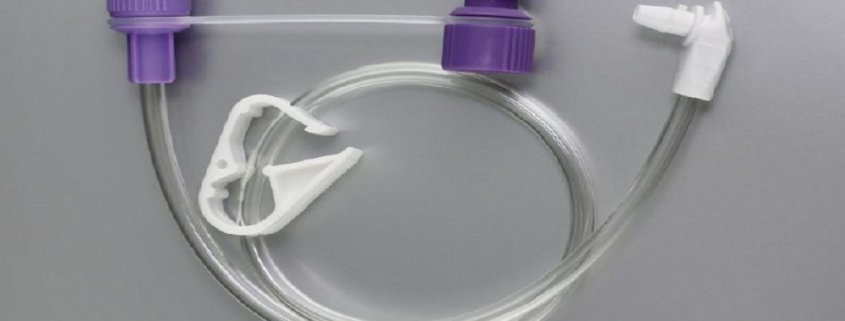Enteral Feeding Devices for Sustaining Adequate Hydration and Nutrition
The global enteral feeding devices market is evaluated at US$1,733.074 million for 2020 and is projected to grow at a CAGR of 4.26% to reach the market size of US$2,320.075 million by 2027. Enteral feeding, which includes oral and tube feeding, is the process of swallowing food through the digestive system. These feedings are often administered when a person is unable to satisfy the nutritional needs of his or her body. The nasogastric tube (NGT), orogastric tube (OGT), jejunostomy tube, mesenteric tube, and orocenteric tube are the most used enteral feeding devices. These tubes support patients’ GI tract health while ensuring they receive the nourishment their bodies require. Patients who have a functional and accessible GI tract but are unable to ingest or absorb enough foods to maintain appropriate nutrition and hydration have enteral access feeding devices implanted. The burden of chronic illnesses, the number of preventable deaths, and the expanding need for enteral feeding in contexts of at-home care are further reasons driving the market’s expansion. The enteral feeding devices market also gives you a thorough market analysis for every nation, including information on the increase in capital healthcare expenditures, the installed base of various enteral feeding devices market products, the impact of technology using lifeline curves, and changes in healthcare regulatory scenarios and their effects on the enteral feeding devices market.
The rising of population and the high prevalence of diabetes has increased the use of enteral feeding systems has grown this market at a rapid pace.
The main drivers of this market’s expansion are the aging population and its consequent rise in the incidence of chronic diseases, the switch from parenteral to enteral nutrition, technical improvements in enteral feeding systems, and rising demand for enteral feeding in home care settings. Additionally, the prevalence of enteral nutrition in developing nations offers considerable potential prospects for market participants. With a constant rise in those 60 and older, the world’s population is aging quickly. The market for enteral feeding devices is expanding due to the frequency of diseases. The market for enteral feeding devices is anticipated to expand as a result of the rising demand.
To address the patient’s nutritional demands, a dietician highly advises enteral feeding for diabetics. The incidence of diabetes is rising alarmingly, and it is predicted that this trend will persist soon. om patients who rely on feeding devices and the requirement for therapy supported by these devices.
Additionally, a substantial market for prefilled syringes is anticipated as autoimmune illnesses including cancer, diabetes, and cardiovascular disease become more prevalent. According to the World Health Organization (WHO), around 17.9 million fatalities worldwide, or 32% of all deaths, were attributed to rising cardiovascular disease cases.
The rising enteral nutrition is becoming more popular, which is boosting demand for enteral feeding devices which led the market growth.
As enteral feeding works better with the body’s natural functions, the gut’s functionality, structural integrity, and immunological advantages are preserved. Even with large abdominal and/or gastrointestinal surgeries, early enteral feeding is linked to improved postoperative results. Compared to parenteral feeding, early enteral nutrition (12 hours after surgery) is linked to lower viral infections and improved nitrogen retention. Compared to enteral feeding, total parenteral nutrition (TPN) is more costly. As a result, patients and their families may find it difficult to afford the cost of long-term artificial nourishment with TPN. Parenteral feeding is not as physiological, easy, safe, cost-effective, or as complex as enteral feeding. Parenteral feeding is also linked to an increase in infectious problems.
Enteral feeding is advised as the first line of nutrition assistance as it is becoming more widely acknowledged to have advantages over parenteral feeding. It is widely accepted that enteral nutrition is an affordable, secure, and efficient type of nutritional support that complies with physiological requirements, supports maintaining the morphology and functionality of the digestive system, works, and has minimal difficulties. In addition to these advantages, enteral eating is beneficial before, during, and after several surgical operations because it reduces bacterial translocation, stress hormone release, cytokine response, and energy consumption. These advantages make enteral feeding more popular than parenteral feeding, propelling the industry.
According to analysts, Asia Pacific held a dominant Enteral Feeding Devices Market Share to Witness Growth During Year-on-year
The North American, European, Middle Eastern and African, South American, and Asia Pacific regions have been divided geographically into the worldwide market for enteral feeding devices. The fastest-growing market is in Asia Pacific. On a regional basis, North America is anticipated to have the greatest market share for enteral feeding devices in 2022 as In the United States, according to National Cancer Institute an estimated 1.86 million cancer cases were identified in 2020, and the illness claimed the lives of more than 55,000 people. However, it is projected that Asia-Pacific would see the highest growth over the period. The market is expected to grow as a result of the rising incidence of a variety of disorders and serious illnesses that can cause malnutrition, initiatives to promote enteral nutrition use, and the implementation of regulations for the proper use of enteral nutrition for the care of new-borns and senior citizens. Additionally, due to the increasing number of cases of malnutrition and enteral nutrition improvement efforts, China is predicted to have the highest share of the Asia-Pacific enteral nutrition market.



